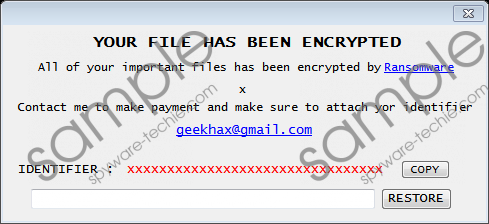Do you know what Final Ransomware is?
Our malware analysts say that Final Ransomware is far from being final. They believe that it is still in development or might have been created by rookie programmers because the way it works is not that impressive. It is a low-grade ransomware, but it works and gets the job done nonetheless. You have to remove it if your PC becomes infected with it because it was designed to encrypt your personal files and then offer you to buy a decryption key to decrypt them. However, you should reconsider paying the ransom because its creators might not keep their word and provide you with a decryption key once you have paid. While this has not been proven, we think you would take a big risk by trusting them. Also, the amount they expect you to pay is not specified in the ransom note.
Once Final Ransomware has infected a computer, it goes to work immediately and starts encrypting files located in Downloads, Videos, Music, Documents, and Pictures folders including the computer’s desktop. The list of encryptable file extensions is unknown, but testing has shown that it is capable of encrypting many file extensions. Researchers say that this ransomware should use either the AES or RSA encryption algorithm and generate a public encryption and private decryption keys. Researchers say that this ransomware connects to http://marketingdiff.com/uploads/ransomware.php to generate the keys. However, if your PC is not connected to the Internet during the encryption, then it will not do that and will not display the ransom note. This ransomware appends all encrypted files with an ".encrypted" file extension.
But, if you have an Internet connection, then this ransomware will render its ransom note once the encryption is complete. The note says that you must pay 28 USD to get the key to decrypt your files. Of course, while the note does not state that, we are positive that you will have to pay in Bitcoins. In order to make the payment, you must message the developers via the provided email address. Note that if you click the RESTORE button, this ransomware Final Ransomware will decrypt some files, but permanently corrupt others, so do not click that button without entering the decryption key first. However, we do not recommend that you purchase the decryption key because the criminals might not keep their end of the bargain and send it to you. Final Ransomware screenshot
Final Ransomware screenshot
Scroll down for full removal instructions
Now let us discuss how the developers might distribute Final Ransomware. Our malware analysts say that Final Ransomware should be distributed using email spam. They have received unconfirmed reports suggesting that this ransomware’s developers have set up an email server that sends this ransomware as an attached file. The main executable should be zipped and might be disguised as a legitimate file. In some cases, the file can named AppleFinal.exe or FinalRansomware.exe, but the name can vary to avoid unnecessary suspicion. If you run or extract the file and run it afterward, then it might be placed in the %TEMP% or Downloads folder, but, again, due to your personal configuration, the file can be extracted elsewhere.
Our malware analysts consider Final Ransomware as a dangerous computer infection even though it has not been fully completed yet. It is capable of encrypting your personal files and then offers you to purchase a decryption key but, as mentioned, its developers might not send you the decryption key once you have paid. Therefore, our cyber security experts recommend you use SpyHunter or our manual removal guide to delete Final Ransomware.
How to delete this ransomware
- Press Windows+E key.
- Type %TEMP% and C:\Users\{UserName}\Downloads in the address box.
- Hit the Enter button.
- Find AppleFinal.exe or FinalRansomware.exe (name can be random)
- Right-click it and click Delete.
- Empty the Recycle Bin.
In non-techie terms:
Final Ransomware is a dangerous computer infection designed to encrypt your most personal files and demand money to decrypt them. Its creators are cyber criminals that engage is extortion, so you should not comply with their demands. This ransomware might enter your PC via malicious email, so you ought to stay vigilant and protect your PC with an antimalware tool. If your PC has become infected with this malware, then you must remove it.
